About
I am currently an Assistant Professor at the Department of Mathematics, Nazarbayev University, Kazakhstan.
I received a Ph.D. in Computational Science, Engineering and Mathematics (CSEM) at the Oden Institute for Computational Engineering and Sciences (ICES) in the University of Texas at Austin, where I was at the Center for Subsurface Modeling and I was supervised by Professor Mary Wheeler.

My research interest brings together interdisciplinary areas of mathematics, physics, engineering and computational science. In particularly, my research focuses on the numerical analysis of partial differential systems that arise in subsurface phenomena using mathematical modeling and scientific computation. My main interests are finite element methods, numerical analysis including a priori and a posteriori error analysis, scientific computing, computational transport phenomena and numerical reservoir simulations. My Ph.D. work has given me an opportunity to study these problems theoretically and numerically by taking into account experimental laboratory data work.

Research
Subsurface reservoir flow and transport modeling is important in many subsurface applications such as Enhanced Oil Recovery (EOR), CO2 sequestration, groundwater remediation as well as contaminant plume migration in heterogeneous porous media. I am working on these projects:
- Developing a new adaptive numerical homogenization method to handle multiscale nature of flow and transport problems of heterogeneous subsurface
- A priori analysis for slightly compressible flow using Enhanced Velocity Mixed Finite Element Method (EVMFEM).
- A posteriori error analysis for incompressible flow problems using EVMFEM
- Time domain decomposition methods for flow and transport in heterogeneous porous media problems
In addition, I was selected to attend Research Experience Carbon Sequestration program 2017 and this program gave me opportunity to explore the important stages of Carbon Capture, Utilization and Storage (CCUS). Field trips including industrial and geological sites were valuable for better understanding CCUS complexities as well as helped to expand my practical interpretation skills.
